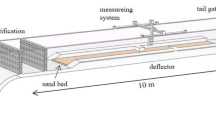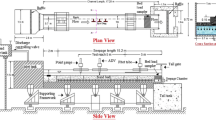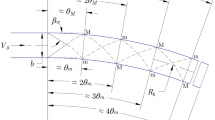Abstract
FLUIDS flowing through pipes or channels can develop secondary currents. These are defined as currents which occur in the plane normal to the local axis of the primary flow. Their development in straight channels has been ascribed to anisotropic turbulence and the non-uniform distribution of boundary shear stress1–3 but in meander bends they are generally caused by skewing of the flow3–5. Secondary currents distort the distributions of primary isovels and boundary shear stress from those expected in simple flows and, therefore, have important implications for bed and bank erosion and for resistence to flow. We report here measurements of longstream and cross stream velocities carried out across sections of a river perpendicular to the outer banks of several bends using an electromagnetic flow meter.
This is a preview of subscription content, access via your institution
Access options
Subscribe to this journal
Receive 51 print issues and online access
$199.00 per year
only $3.90 per issue
Buy this article
- Purchase on SpringerLink
- Instant access to full article PDF
Prices may be subject to local taxes which are calculated during checkout
Similar content being viewed by others
References
Brundrett, E. & Baines, W. D. J. Fluid Mech. 19, 375–394 (1964).
Gessner, F. B. & Jones, J. B. J. Fluid Mech. 23, 689–713 (1965).
Perkins, H. J. J. Fluid Mcch. 44, 721–740 (1970).
Squire, H. B. & Winter, K. G. J. Aero. Sci. 18, 271–277 (1951).
Prandtl, L. Essentials of Fluid Dynamics (Blackie, London, 1952).
Thomson, J. Proc. R. Soc. 25, 5–8 (1876).
Hawthorne, W. R., Proc. R. Soc. A206, 374–387 (1951).
Fox, J. A. & Ball, D. J. Proc. Instn Civ. Engrs 39, 467–475 (1968).
Quick, M. C. Proc. Am. Soc. civ. Engrs J. Hydraul. Div. 100, 741–753 (1974).
Einstein, H. A. & Harder, J. A. Trans. Am. geophys. Un. 35, 114–120 (1954).
Rozovskii, I. L. Flow of Water in Bends of Open Channels (transl. by Israel Program for Scientific Translations, Jerusalem, 1961).
Hey, R. D. & Thorne, C. R. Area 7, 191–195 (1975); 8, 234–236 (1976).
Bridge, J. S. & Jarvis, J. Earth Surf. Proces. 1, 303–336 (1976).
Rowe, M. J. Fluid Mech. 43, 771–783 (1970).
Chacinski, T. M. & Francis, J. R. D. Trans. Am. gcophys. Un. 33, 771–773 (1952).
Toebes, G. H. & Sooky, A. A. Proc. Am. Soc. civ. Engrs J. Water Harb. Div. 93, 213–236 (1967).
Tucker, M. J., Proc. Soc. Underwater Technol. 2, 53–58 (1972).
Kanwisher, J. & Lawson, K. Limnol. Oceanogr. 20, 174–182 (1975).
Author information
Authors and Affiliations
Additional information
The erratum article can be found online at https://doi.org/10.1038/270191d0
Rights and permissions
About this article
Cite this article
BATHURST, J., THORNE, C. & HEY, R. Direct measurements of secondary currents in river bends. Nature 269, 504–506 (1977). https://doi.org/10.1038/269504a0
Received:
Accepted:
Published:
Issue date:
DOI: https://doi.org/10.1038/269504a0
This article is cited by
-
The impact of vegetation on meandering rivers
Nature Reviews Earth & Environment (2022)
-
A zero-flux principle for extracting secondary flows in arbitrary vertical planes of natural rivers
Journal of Hydrodynamics (2022)
-
Evolution of outer bank cell in open-channel bends
Environmental Fluid Mechanics (2022)
-
A tenfold slowdown in river meander migration driven by plant life
Nature Geoscience (2020)
-
Vertical velocity in rectangular channel bends: numerical study and development of a prediction formula
Journal of the Brazilian Society of Mechanical Sciences and Engineering (2019)



